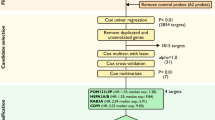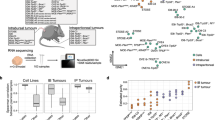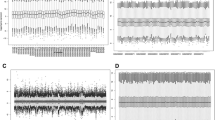Abstract
Patients with advanced epithelial ovarian cancer often experience disease recurrence after standard therapies, a critical factor in determining their five-year survival rate. Recent reports indicated that long-term or short-term survival is associated with varied gene expression of cancer cells. Thus, identification of novel prognostic biomarkers should be considered. Since the mouse genome is similar to the human genome, we explored potential prognostic biomarkers using two groups of mouse ovarian cancer cell lines (group 1: IG-10, IG-10pw, and IG-10pw/agar; group 2: IG-10 clones 2, 3, and 11) which display highly and moderately aggressive phenotypes in vivo. Mice injected with these cell lines have different survival time and rates, capacities of tumor, and ascites formations, reflecting different prognostic potentials. Using an Affymetrix Mouse Genome 430 2.0 Array, a total of 181 genes were differentially expressed (P < 0.01) by at least twofold between two groups of the cell lines. Of the 181 genes, 109 and 72 genes were overexpressed in highly and moderately aggressive cell lines, respectively. Analysis of the 109 and 72 genes using Ingenuity Pathway Analysis (IPA) tool revealed two cancer-related gene networks. One was associated with the highly aggressive cell lines and affiliated with MYC gene, and another was associated with the moderately aggressive cell lines and affiliated with the androgen receptor (AR). Finally, the gene enrichment analysis indicated that the overexpressed 89 genes (out of 109 genes) in highly aggressive cell lines had a function annotation in the David database. The cancer-relevant significant gene ontology (GO) terms included Cell cycle, DNA metabolic process, and Programmed cell death. None of the genes from a set of the 72 genes overexpressed in the moderately aggressive cell lines had a function annotation in the David database. Our results suggested that the overexpressed MYC and 109 gene set represented highly aggressive ovarian cancer potential biomarkers while overexpressed AR and 72 gene set represented moderately aggressive ovarian cancer potential biomarkers. Based on our knowledge, the current study is first time to report the potential biomarkers relevant to different aggressive ovarian cancer. These potential biomarkers provide important information for investigating human ovarian cancer prognosis.




Similar content being viewed by others
References
Gloss BS, Samimi G. Epigenetic biomarkers in epithelial ovarian cancer. Cancer Lett. 2014;342:257–63.
Cannistra SA. Cancer of the ovary. N Engl J Med. 2004;351:2519–29.
Jemal A, Siegel R, Xu J, Ward E. Cancer statistics, 2010. CA Cancer J Clin. 2010;60:277–300.
du Bois A, Luck HJ, Meier W, Adams HP, Mobus V, Costa S, et al. A randomized clinical trial of cisplatin/paclitaxel versus carboplatin/paclitaxel as first-line treatment of ovarian cancer. J Natl Cancer Inst. 2003;95:1320–9.
Ozols RF, Bundy BN, Greer BE, Fowler JM, Clarke-Pearson D, Burger RA, et al. Phase III trial of carboplatin and paclitaxel compared with cisplatin and paclitaxel in patients with optimally resected stage III ovarian cancer: a Gynecologic Oncology Group study. J Clin Oncol. 2003;21:3194–200.
Skirnisdottir IA, Sorbe B, Lindborg K, Seidal T. Prognostic impact of p53, p27, and C-MYC on clinicopathological features and outcome in early-stage (FIGO I-II) epithelial ovarian cancer. Int J Gynecol Cancer. 2011;21:236–44.
Nikas JB, Boylan KL, Skubitz AP, Low WC. Mathematical prognostic biomarker models for treatment response and survival in epithelial ovarian cancer. Cancer Informat. 2011;10:233–47.
Kamieniak MM, Rico D, Milne RL, Munoz-Repeto I, Ibanez K, Grillo MA, et al. Deletion at 6q24.2-26 predicts longer survival of high-grade serous epithelial ovarian cancer patients. Mol Oncol. 2015;9:422–36.
Roby KF, Taylor CC, Sweetwood JP, Cheng Y, Pace JL, Tawfik O, et al. Development of a syngeneic mouse model for events related to ovarian cancer. Carcinogenesis. 2000;21:585–91.
Li XL, Zhang DQ, Wang D, Knight DS, Yin L, Bao J, et al. In vivo survivors of transformed mouse ovarian surface epithelial cells display diverse phenotypes for gene expression and tumorigenicity. Tumour Biol. 2008;29:359–70.
Urzua U, Frankenberger C, Gangi L, Mayer S, Burkett S, Munroe DJ. Microarray comparative genomic hybridization profile of a murine model for epithelial ovarian cancer reveals genomic imbalances resembling human ovarian carcinomas. Tumour Biol. 2005;26:236–44.
D’Andrilli G, Giordano A, Bovicelli A. Epithelial ovarian cancer: the role of cell cycle genes in the different histotypes. Open Clin Cancer J. 2008;2:7–12.
D’Andrilli G, Kumar C, Scambia G, Giordano A. Cell cycle genes in ovarian cancer: steps toward earlier diagnosis and novel therapies. Clin Cancer Res. 2004;10:8132–41.
Saldanha SN, Tollefsbol TO. Pathway modulations and epigenetic alterations in ovarian tumorbiogenesis. J Cell Physiol. 2014;229:393–406.
Yoshida S, Furukawa N, Haruta S, Tanase Y, Kanayama S, Noguchi T, et al. Expression profiles of genes involved in poor prognosis of epithelial ovarian carcinoma: a review. Int J Gynecol Cancer. 2009;19:992–7.
Sirotkin AV. Transcription factors and ovarian functions. J Cell Physiol. 2010;225:20–6.
Farley J, Ozbun LL, Birrer MJ. Genomic analysis of epithelial ovarian cancer. Cell Res. 2008;18:538–48.
Yin F, Liu X, Li D, Wang Q, Zhang W, Li L. Tumor suppressor genes associated with drug resistance in ovarian cancer (review). Oncol Rep. 2013;30:3–10.
Materna V, Surowiak P, Markwitz E, Spaczynski M, Drag-Zalesinska M, Zabel M, et al. Expression of factors involved in regulation of DNA mismatch repair- and apoptosis pathways in ovarian cancer patients. Oncol Rep. 2007;17:505–16.
Baserga R, Porcu P, Sell C. Oncogenes, growth factors and control of the cell cycle. Cancer Surv. 1993;16:201–13.
Zimonjic DB, Popescu NC. Role of DLC1 tumor suppressor gene and MYC oncogene in pathogenesis of human hepatocellular carcinoma: potential prospects for combined targeted therapeutics (review). Int J Oncol. 2012;41:393–406.
Delgado MD, Albajar M, Gomez-Casares MT, Batlle A, Leon J. MYC oncogene in myeloid neoplasias. Clin Transl Oncol. 2013;15:87–94.
Tamai Y, Taketo M, Nozaki M, Seldin MF. Mouse Elk oncogene maps to chromosome X and a novel Elk oncogene (Elk3) maps to chromosome 10. Genomics. 1995;26:414–6.
Pickeral OK, Li JZ, Barrow I, Boguski MS, Makalowski W, Zhang J. Classical oncogenes and tumor suppressor genes: a comparative genomics perspective. Neoplasia. 2000;2:280–6.
Gailani MR, Bale SJ, Leffell DJ, DiGiovanna JJ, Peck GL, Poliak S, et al. Developmental defects in Gorlin syndrome related to a putative tumor suppressor gene on chromosome 9. Cell. 1992;69:111–7.
Agren M, Kogerman P, Kleman MI, Wessling M, Toftgard R. Expression of the PTCH1 tumor suppressor gene is regulated by alternative promoters and a single functional Gli-binding site. Gene. 2004;330:101–14.
Enrietto PJ. The myc oncogene in avian and mammalian carcinogenesis. Cancer Surv. 1987;6:85–99.
Slotman BJ, Nauta JJ, Rao BR. Survival of patients with ovarian cancer. Apart from stage and grade, tumor progesterone receptor content is a prognostic indicator. Cancer. 1990;66:740–4.
Tonin PN, Hudson TJ, Rodier F, Bossolasco M, Lee PD, Novak J, et al. Microarray analysis of gene expression mirrors the biology of an ovarian cancer model. Oncogene. 2001;20:6617–26.
Werman A, Werman-Venkert R, White R, Lee JK, Werman B, Krelin Y, et al. The precursor form of IL-1alpha is an intracrine proinflammatory activator of transcription. Proc Natl Acad Sci U S A. 2004;101:2434–9.
Grisaru D, Hauspy J, Prasad M, Albert M, Murphy KJ, Covens A, et al. Microarray expression identification of differentially expressed genes in serous epithelial ovarian cancer compared with bulk normal ovarian tissue and ovarian surface scrapings. Oncol Rep. 2007;18:1347–56.
Morgenbesser SD, DePinho RA. Use of transgenic mice to study myc family gene function in normal mammalian development and in cancer. Semin Cancer Biol. 1994;5:21–36.
Watson JV, Curling OM, Munn CF, Hudson CN. Oncogene expression in ovarian cancer: a pilot study of c-myc oncoprotein in serous papillary ovarian cancer. Gynecol Oncol. 1987;28:137–50.
Somay C, Grunt TW, Mannhalter C, Dittrich C. Relationship of myc protein expression to the phenotype and to the growth potential of HOC-7 ovarian cancer cells. Br J Cancer. 1992;66:93–8.
Katsaros D, Theillet C, Zola P, Louason G, Sanfilippo B, Isaia E, et al. Concurrent abnormal expression of erbB-2, myc and ras genes is associated with poor outcome of ovarian cancer patients. Anticancer Res. 1995;15:1501–10.
Kuhnel R, de Graaff J, Rao BR, Stolk JG. Androgen receptor predominance in human ovarian carcinoma. J Steroid Biochem. 1987;26:393–7.
Cardillo MR, Petrangeli E, Aliotta N, Salvatori L, Ravenna L, Chang C, et al. Androgen receptors in ovarian tumors: correlation with oestrogen and progesterone receptors in an immunohistochemical and semiquantitative image analysis study. J Exp Clin Cancer Res. 1998;17:231–7.
Ilekis JV, Connor JP, Prins GS, Ferrer K, Niederberger C, Scoccia B. Expression of epidermal growth factor and androgen receptors in ovarian cancer. Gynecol Oncol. 1997;66:250–4.
Lau KM, Mok SC, Ho SM. Expression of human estrogen receptor-alpha and -beta, progesterone receptor, and androgen receptor mRNA in normal and malignant ovarian epithelial cells. Proc Natl Acad Sci U S A. 1999;96:5722–7.
Nodin B, Zendehrokh N, Brandstedt J, Nilsson E, Manjer J, Brennan DJ, et al. Increased androgen receptor expression in serous carcinoma of the ovary is associated with an improved survival. J Ovarian Res. 2010;3:14.
Uchida F, Uzawa K, Kasamatsu A, Takatori H, Sakamoto Y, Ogawara K, et al. Overexpression of CDCA2 in human squamous cell carcinoma: correlation with prevention of G1 phase arrest and apoptosis. PLoS One. 2013;8:e56381.
de Bruin A, Maiti B, Jakoi L, Timmers C, Buerki R, Leone G. Identification and characterization of E2F7, a novel mammalian E2F family member capable of blocking cellular proliferation. J Biol Chem. 2003;278:42041–9.
Liebermann DA, Hoffman B. Prostate cancer: JunD, Gadd45a and Gadd45g as therapeutic targets. Cell Cycle. 2011;10:3428.
Brooks WS, Helton ES, Banerjee S, Venable M, Johnson L, Schoeb TR, et al. G2E3 is a dual function ubiquitin ligase required for early embryonic development. J Biol Chem. 2008;283:22304–15.
Dang CV. MYC on the path to cancer. Cell. 2012;149:22–35.
Acknowledgments
We would like to thank Dr. Erik K. Flemington (Tulane University) for providing software and helping us to analyze microarray data. We also thank Mr. Reginald Starks (Xavier University) for taking care of the animals used in this study. RCMI and LCRC Core Facilities and RCMI Bioinformatics Facility are gratefully acknowledged for providing support for this study.
Grant support
This study was supported by funding from NIH (RCMI, 2G12MD007595) and Louisiana Cancer Research Consortium (LCRC) to Dr. Qian-Jin Zhang.
Authorship
Fengkun Du conducted most of the microarray analysis. Yan Li and Xiao-Lin Li did cell culture and animal works. Shubha P. Kale, Harris McFerrin, Ian Davenport, Guangdi Wang, Yuan-Xiang Meng, and Yong-Yu Liu analyzed data and participated in the many discussions on the findings and follow-up experiments. Elena Skripnikova did RT-PCR analysis. Nathan J. Bowen did part of microarray analysis. Leticia B. McDaniels is undergraduate student who participated in and assisted with the experiments. Paula Polk did microarray.
Author information
Authors and Affiliations
Corresponding author
Ethics declarations
Conflicts of interest
None
Additional information
Fengkun Du and Yan Li are co-first authors.
Fengkun Du and Yan Li contributed equally to this work.
Rights and permissions
About this article
Cite this article
Du, F., Li, Y., Zhang, W. et al. Highly and moderately aggressive mouse ovarian cancer cell lines exhibit differential gene expression. Tumor Biol. 37, 11147–11162 (2016). https://doi.org/10.1007/s13277-015-4518-4
Received:
Accepted:
Published:
Issue Date:
DOI: https://doi.org/10.1007/s13277-015-4518-4




